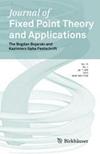关于一些定点技术在弗雷德霍姆第二类积分方程中的应用
IF 1.1
3区 数学
Q1 MATHEMATICS
引用次数: 0
摘要
众所周知,连续逼近法的全局收敛性是通过巴拿赫收缩原理获得的。在本文中,我们通过使用辅助点的技术来研究该方法的全局收敛性,并由此获得闭球上的定点类型结果。我们将这项研究应用于非线性弗雷德霍姆第二类积分方程。本文章由计算机程序翻译,如有差异,请以英文原文为准。
On the application of some fixed-point techniques to Fredholm integral equations of the second kind
It is known that the global convergence of the method of successive approximations is obtained by means of the Banach contraction principle. In this paper, we study the global convergence of the method by means of a technique that uses auxiliary points and, as a consequence of this study, we obtain fixed-point type results on closed balls. We apply the study to nonlinear Fredholm integral equations of the second kind.
求助全文
通过发布文献求助,成功后即可免费获取论文全文。
去求助
来源期刊
CiteScore
3.10
自引率
5.60%
发文量
68
审稿时长
>12 weeks
期刊介绍:
The Journal of Fixed Point Theory and Applications (JFPTA) provides a publication forum for an important research in all disciplines in which the use of tools of fixed point theory plays an essential role. Research topics include but are not limited to:
(i) New developments in fixed point theory as well as in related topological methods,
in particular:
Degree and fixed point index for various types of maps,
Algebraic topology methods in the context of the Leray-Schauder theory,
Lefschetz and Nielsen theories,
Borsuk-Ulam type results,
Vietoris fractions and fixed points for set-valued maps.
(ii) Ramifications to global analysis, dynamical systems and symplectic topology,
in particular:
Degree and Conley Index in the study of non-linear phenomena,
Lusternik-Schnirelmann and Morse theoretic methods,
Floer Homology and Hamiltonian Systems,
Elliptic complexes and the Atiyah-Bott fixed point theorem,
Symplectic fixed point theorems and results related to the Arnold Conjecture.
(iii) Significant applications in nonlinear analysis, mathematical economics and computation theory,
in particular:
Bifurcation theory and non-linear PDE-s,
Convex analysis and variational inequalities,
KKM-maps, theory of games and economics,
Fixed point algorithms for computing fixed points.
(iv) Contributions to important problems in geometry, fluid dynamics and mathematical physics,
in particular:
Global Riemannian geometry,
Nonlinear problems in fluid mechanics.

 求助内容:
求助内容: 应助结果提醒方式:
应助结果提醒方式:


